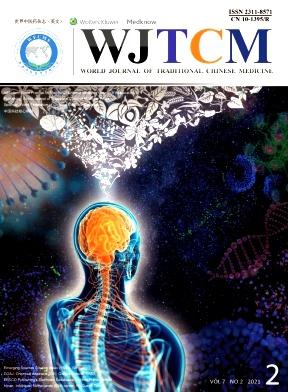Effects of acupuncture at Tianshu (ST25) and Shangjuxu (ST37) on the intestinal mucosa and metabolites of local skin tissues at Tianshu (ST25) in 2,4,6-Trinitrobenzene sulfonic acid and ethanol-induced rats
IF 3.2
3区 医学
Q1 INTEGRATIVE & COMPLEMENTARY MEDICINE
引用次数: 0
Abstract
Objective: To observe the effect of acupuncture on local skin tissue metabolites of Tianshu (ST25) in rats with Crohn's disease (CD) using metabolomics and to explore the mechanism of acupuncture treatment metabolites and pathway on local skin tissue of Tianshu (ST25). Materials and Methods: Thirty-eight Sprague − Dawley rats were randomly assigned to a normal group (n = 14) and a CD modeling group (n = 24). Rats in the CD modeling group were administered with 2,4,6-trinitrobenzene sulfonic acid and ethanol enema, in addition to the normal group. Four normal rats and four CD modeling rats were selected at random after model identification was established. Furthermore, CD modeling group rats were randomly assigned to two groups of 10 rats: the model group and acupuncture group. Rats in the acupuncture group underwent acupuncture of Tianshu (ST25) and Shangjuxu (ST37) for 7 days. After the intervention, the colon tissue was collected from each group of rats and the pathological changes were observed through hematoxylin and eosin (HE) staining. The local skin tissues at Tianshu (ST25) of the rats in each group were taken, and the proton nuclear magnetic resonance technique was used to detect the metabonomics of the local skin tissues of Tianshu (ST25) in rats. Results: Compared with the normal group, the following were observed in the model group after HE staining: irregular colon morphology and other pathological changes such as intestinal mucosal hyperemia, edema, ulcers, polyps, and inflammatory cell infiltration. In the acupuncture group, colon tissue structure was relatively complete and layered, the colon gland structure was restored, and inflammatory cell infiltration was significantly improved. The choline, glycerin, glycine, guanidoacetic acid, and proline levels were significantly higher in the model group than in the normal group (P < 0.05 or P < 0.01). Compared with the model group, the acupuncture group had significantly increased contents of alanine, leucine, L-phenylalanine, and tyrosine in the skin (P < 0.05 or P < 0.01). Valine, leucine, and L-isoleucine biosynthesis and L-phenylalanine metabolism were the main metabolic pathways involved in the changes in the local skin tissues of the rats in each group, biosynthesis of tyrosine, and tryptophan. Conclusion: The change in the metabolites in the local area of Tianshu (ST25) may be related to intestinal disease. The acupuncture of Tianshu (ST25) can improve intestinal inflammatory reaction in rats with CD, and this finding may be related to the regulation of amino acid metabolites and their pathways in the local acupoint tissues of Tianshu (ST25) by acupuncture.针刺天枢穴(ST25)和上巨枢穴(ST37)对2,4,6-三硝基苯磺酸和乙醇诱导大鼠肠黏膜及天枢穴局部皮肤组织代谢物的影响
目的:采用代谢组学方法观察针刺对克罗恩病(CD)大鼠局部皮肤组织天枢(ST25)代谢物的影响,探讨针刺治疗天枢(ST25)局部皮肤组织代谢物的作用机制和途径。材料与方法:将38只大鼠随机分为正常组(n = 14)和CD造模组(n = 24)。CD造模组大鼠在正常组基础上灌胃2,4,6-三硝基苯磺酸和乙醇灌肠。建立模型后,随机选取正常大鼠4只,CD造模大鼠4只。将CD造模组大鼠随机分为两组,每组10只:造模组和针刺组。针刺组大鼠分别针刺天枢(ST25)和上巨虚(ST37) 7 d。干预后,取各组大鼠结肠组织,采用苏木精和伊红(HE)染色观察病理变化。取各组大鼠天枢(ST25)局部皮肤组织,采用质子核磁共振技术检测大鼠天枢(ST25)局部皮肤组织代谢组学。结果:与正常组比较,HE染色后模型组结肠形态不规则,肠黏膜充血、水肿、溃疡、息肉、炎性细胞浸润等病理改变。针刺组结肠组织结构较为完整分层,结肠腺体结构恢复,炎症细胞浸润明显改善。模型组大鼠胆碱、甘油、甘氨酸、胍乙酸、脯氨酸水平均显著或极显著高于正常组(P < 0.05或P < 0.01)。与模型组比较,针刺组皮肤中丙氨酸、亮氨酸、l -苯丙氨酸、酪氨酸含量均显著或极显著升高(P < 0.05或P < 0.01)。缬氨酸、亮氨酸和l -异亮氨酸的生物合成和l -苯丙氨酸的代谢是各组大鼠局部皮肤组织变化以及酪氨酸和色氨酸生物合成的主要代谢途径。结论:天枢局部代谢物的变化可能与肠道疾病有关。针刺天枢(ST25)可改善CD大鼠肠道炎症反应,这一发现可能与针刺调节天枢(ST25)局部穴位组织氨基酸代谢物及其通路有关。
本文章由计算机程序翻译,如有差异,请以英文原文为准。
求助全文
约1分钟内获得全文
求助全文
来源期刊

World Journal of Traditional Chinese Medicine
Medicine-Complementary and Alternative Medicine
CiteScore
5.40
自引率
2.30%
发文量
259
审稿时长
24 weeks
 求助内容:
求助内容: 应助结果提醒方式:
应助结果提醒方式:


